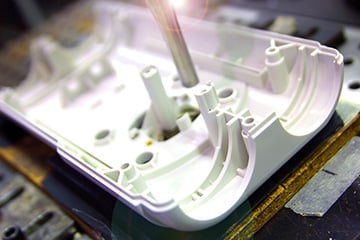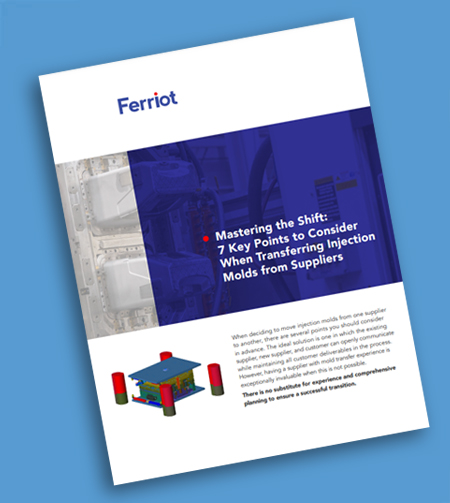Insert molding is another type of injection molding (IM) process: In this process an insert is placed in the mold either manually or through automation before injecting resin material around it to secure it in place. This insert can be made of different types of metal, including steel and aluminum and/or non-metal components. In some instances, the inserts are simple designs such as electrical leads, fastener, pins, or sheet metal. Other times, wire meshes and plates are used as inserts, strengthening the final product of the injection molded unit. These are not the only options for injection molded inserts—more complex designs can also be molded as inserts.
By molding around inserts, this technique of injection molding can reduce assembly and labor costs as compared with incorporating the elements in final assembly. Because the insert is efficiently placed as part of the IM process instead of being placed after molding, the part can also be made smaller. No fasteners or mating joints are required. Design flexibility is a key benefit to insert molding as well as other overall improvements: increased component strength and decreased part size and weight.
Insert Injection Molding and Tolerances
The tolerance requirements for molding around an insert are relatively tight. In this process, the resins are being molded around a pre-existing unit. If the mold is off by even a fraction of a millimeter, the part will not function as intended. Ferriot’s design and engineering team works closely with our clients to ensure that the strictest tolerances are consistently produced. We also have several solid partnerships with vendors to provide on-spec metal (and non-metal) inserts for injection molding. Realizing all the benefits this type of IM technique can offer means getting it right—with the right design partner.
means getting it right—with the right design partner.
Important Considerations for Insert Molding
Verifying the design and tolerances for the component(s) to be injection molded is key, but there are other things to consider, too. The insert must be able to withstand the extreme temperatures and high pressure of the injection molding process. For this reason, it is imperative that you are familiar with the insert provider and their ability to maintain consistent quality. Consider, too, the initial tooling design cost could be increased due to the fact that the molds will need a way to “hold on” to the inserts until the resin can be injected. Sometimes, tool designs leverage the benefits of bosses or undercuts to offer enhanced retention strength. Creating a reliable way of doing this that lasts the entire duration of the project run can be tricky. Our design and engineering team will work with you to help meet your specific needs while keeping costs down.
If you’re considering a specific project, you may be wondering:
- What kinds of components can be inserted?
- What are the temperature and pressure requirements that my unit or component must be able to withstand?
- How can I calculate the cost comparison between using inserts versus using finish assembly?
If you’re ready to discuss your project details, contact us for a quote.




